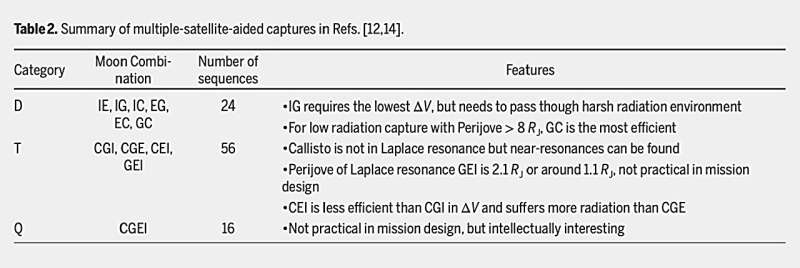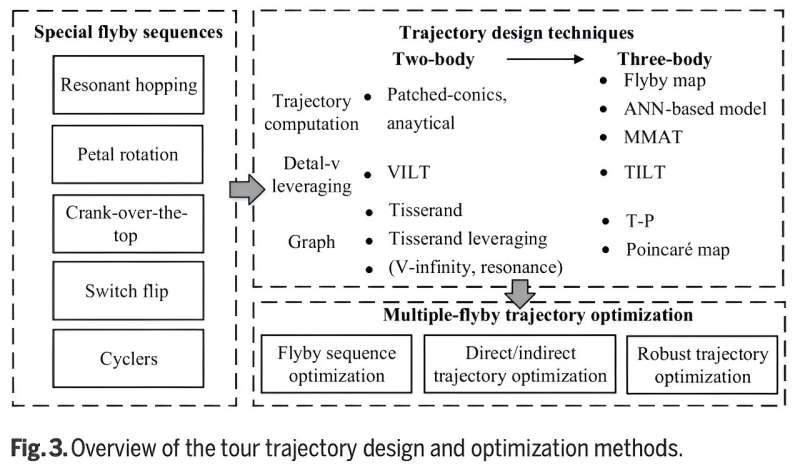This article has been reviewed according to Science X's editorial process and policies. Editors have highlighted the following attributes while ensuring the content's credibility:
fact-checked
proofread
Scientists review the trajectory design and optimization for Jovian system exploration

The Jovian system has long attracted the interest of human exploration. However, Jupiter and its four Galilean moons form a unique and complex multi-body dynamical environment that greatly challenges trajectory design and optimization.
Moreover, the extremely strong radiation environment of Jupiter and the low available fuel of spacecraft further increase the difficulty of trajectory design. In order to satisfy the requirements of diverse missions of the Jovian system exploration, develop new mission concepts, and obtain higher merit with lower cost, a variety of theories and methodologies of trajectory design and optimization were proposed or developed in the past two decades.
There is a lack of comprehensive review of these methodologies, which is unfavorable for further developing new design techniques and proposing new mission schemes.
In a review article recently published in Space: Science & Technology, scholars from Nanjing University of Aeronautics and Astronautics and Rutgers, The State University of New Jersey provide a systematic summarization of the past and state-of-art methodologies for four main exploration phases, including Jupiter capture, the tour of the Galilean moons, Jupiter global mapping, and orbiting around and landing on a target moon.
First, authors review the techniques, design, and optimization of Jupiter capture trajectories. Using the satellite-aided capture technique, the required Δv can be lowered significantly. According to the number of the Galilean moons involved, it can be classified as single-, double-, triple-, and quadruple-satellite-aided captures. In the last century, single-satellite-aided capture condition has been derived by Cline in the two-body problem.
As for multiple-satellite-aided capture through flybys of two or more Galilean moons, the techniques of a phase angle analysis based on the Laplace resonance and the near-resonance of Callisto and Ganymede are proposed to find triple- and quadruple-satellite-aided capture sequences are studied by Lynam et al.
Multiple-satellite-aided capture is more complex but is able to further decrease the required Δv compared with single-satellite-aided capture. In addition, the problem of satellite-aided capture without Δv has been analyzed by Macdonald and McInnes. Other techniques have also been proposed to reduce the cost. A spacecraft with a long tether may generate larger enough Lorentz force as propulsion for capture due to the strong magnetic field of Jupiter.
Solar electric propulsion (SEP) is a favorable option for Jupiter exploration missions because of its much higher specific impulse than the traditional chemical propulsion. The technique of cloudtops arrivals is another approach for efficiently achieving Jupiter orbit. Furthermore, the studies on trajectory design and optimization for capturing a spacecraft into a Jovian orbit can be categorized as two cases.
The first case only focuses on the trajectories in the Jupiter system while the second case integrates the heliocentric interplanetary transfers with satellite-aided captures. Various methods for design and optimization are developed, taking different dynamics into consideration.
Second, authors review the tours of Galilean moons. The patched-conics model is often used for efficiently analyzing and designing tour trajectories containing flybys of Galilean moons for its simplicity. Resonant hopping, petal rotation, crank-over-the-top (COT) sequences, switch-flip, and Cyclers are special flyby sequences in the tour of Galilean moons.
The V-infinity leveraging maneuvering (VILM) technique can achieve desired changes on the excess velocity of the spacecraft to the moon, and improve the efficiency of orbit maneuver. The Tisserand graph and the (V-Infinity, Resonance) Graph are useful tools for designers to pick up viable gravity-assist sequences.
Although the two-body techniques are convenient, they do not fully utilize the natural dynamics of the Jupiter-moon system and have limitations in application. Therefore, a series of techniques have been developed for three-body trajectory design. Tisserand–Poincaré graph, Flyby map, and Tisserand-leveraging transfer are developed in a gradual way, for designing low-Δv orbit transfers in CRTBP.
Invariant manifolds of libration point orbits and unstable resonant orbits provide a gateway to design low-cost tour trajectory between moons. Efficiently patching invariant manifolds is an important concern in recent studies. Additionally, a key problem restricting the design efficiency is that the three-body problem cannot be analytically solved and relies on numerical integration.
The popular artificial intelligence (AI) technique provides a new possible approach to address the difficulty. Furthermore, converting low-fidelity trajectories to high-fidelity trajectories is essential in engineering practice. A continuation parameter κ can be used to convert the patched-conics model to the n-body model, according to a continuation method by Bradley and Russell.
As for the optimization, the deterministic optimization of a tour mission includes two parts: (a) the flyby sequence optimization that requires broad search and (b) impulsive and continuous trajectory optimization with a given flyby sequence. However, in an actual mission, there are many uncertainties such as model uncertainties, navigation errors, orbital maneuver errors, etc., thus robust design of trajectories before launch is necessary.

Third, authors review Jupiter global mapping trajectories. Unlike the low-inclination tour trajectories, Jupiter's global mapping trajectories need high inclinations. On the one hand, gravity assists of the Galilean moons can be used to increase the inclinations of the spacecraft.
On the other hand, repeating ground-track orbits are designed under the non-sphere perturbation of Jupiter. In addition, adjusting the exploration orbit around Jupiter may require long-flight-time transfer trajectories, which is challenging due to the convergence problem using the initial guess from a Keplerian Lambert solution.
Forth, authors review moon orbiter and lander trajectories. As for orbits around Galilean moons, low-altitude and near-polar orbits are suitable candidates of science orbits, but highly inclined orbits around Europa are not stable and easy to collide with Europa due to the third-body gravitational effect of Jupiter.
How to design long-life orbits are investigated by different scholars considering tidal force of Jupiter and the J2, C22, J3 and J4 perturbations of Europa. In addition, high-inclination and near-circular artificial frozen orbits around Europa with low thrust are investigated. Solutions of natural frozen orbits are also found for Ganymede and Callisto based on the Milankovitch elements.
Observing a moon using low-energy orbits is an alternative approach, where the heteroclinic and homoclinic connecting between unstable periodic orbits around L1 and L2 points of the Planet-moon three-body system are proposed as mission orbits for observations. As for orbit capture at Galilean moons, the first issue is how to approach the target moon.
The final planar and spatial approach is tied to resonance orbits and resonances required were evaluated using the computation of the invariant manifolds of Lyapunov and halo orbits. Lowering the capture cost is the second important issue, where the temporary capture is a choice. As for landing on Galilean moons, only a few studies have been published on design trajectories for Galilean moon landing.
A brief summary about comparing different techniques and methods is given as follows:
(1) The two-body techniques are useful for designing flyby trajectories in the Jovian system and not able to utilize the multi-body dynamics possibly leading to higher fuel cost, while the three-body techniques or multi-body techniques can further utilize the natural dynamics of the Jovian system but more complex and time-consuming.
(2) Low-thrust techniques can save fuel due to the much higher specific impulse or utilizing the magnetic field of Jupiter. However, the orbit correction ability of low thrust is lower than delta-V, which leads to new navigation challenges.
(3) Most of the existent trajectory optimization methods are deterministic by which the designed trajectories are not robust to the uncertainties and future navigation analysis is required. In contrast, robust trajectory optimization takes the uncertainties into account and the obtained optimal control is robust.
However, robust trajectory optimization is challenging due to propagation of the orbit uncertainties in multi-body dynamics and the large solution space.
According to the current research progress, development in the following aspects is expected in the future: (1) multi-body techniques in engineering mission design, (2) robust trajectory optimization methods, and (3) AI techniques.
More information: Hongwei Yang et al, Review of Trajectory Design and Optimization for Jovian System Exploration, Space: Science & Technology (2023). DOI: 10.34133/space.0036
Provided by Beijing Institute of Technology Press Co., Ltd



















